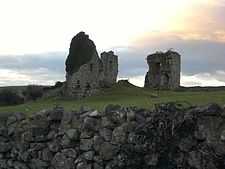Gleaston Castle
| Gleaston Castle | |
|---|---|
| Cumbria, England | |
|
Gleaston Castle ruins in 2005 | |
 Gleaston Castle | |
| Coordinates | grid reference SD261714 |
| Site information | |
| Open to the public | No |
| Site history | |
| Materials | Limestone and sandstone |
Gleaston Castle is situated in a valley about 0.5 km north-east of the village of Gleaston, which lies between the towns of Ulverston and Barrow-in-Furness in the Furness peninsula, Cumbria, England.
Structure
The castle consists of the remains four towers connected by curtain walls around a roughly rectangular courtyard. The walls are made of limestone quarried near the site, whilst details such as window and door surrounds are made of a soft red sandstone, the origins of which are uncertain although it is similar to that used in the construction of nearby Furness Abbey. The walls at the southwestern corner of the site have a clay core, as is usual in castle construction, but elsewhere the core is the same shingle mortar used to face the walls.
History
The castle is first mentioned specifically in 1389, although Sir John de Harrington, 2nd Baron Harington of Aldingham is said to have died at Gleaston in 1369. It is generally assumed that the castle was begun by his grandfather Sir John, 1st Baron Harington at around the time he was summoned to Parliament in 1326. It is possible that part of the structure is earlier and was built as a defence against the Scots who posed a serious threat to the area following Edward I's campaigns and Robert Bruce's assumption of the Scottish throne. The majority of the castle must surely have been built after the devastating 1316 and 1322 Scottish raids on the area as it was built quickly and poorly, with poor quality local materials, suggesting a lack of funds. The castle also lacks the usual fortifications: there was no license to crenellate granted, no gatehouse or barbican and there are no traces of a defensive ditch or moat so it could not have withstood a serious attack.
The castle was the main seat of residence for the Lords of Aldingham until the death of William de Harrington, 5th Baron of Aldingham in 1457. The estate passed to William's daughter Elizabeth who had married William Bonville, 1st Baron Bonville of Shute in Devon and the title of 6th Baron Harington passed to their young son William. The Bonvilles made Devon their main seat of residence and Gleaston Castle was abandoned and quickly fell into disrepair.
William Bonville jnr died along with his father at the Battle of Wakefield in 1460 and the castle fell to his newborn daughter Cecily, who later married Thomas Grey, 1st Marquess of Dorset. Eventually it fell to Henry Grey, 1st Duke of Suffolk who sold the castle and its adjacent demesne land to his bailiff Walter Curwen before he was beheaded for treason in 1554, by which time it was in ruins. One of the southern towers may have been inhabited in the 16th century but by 1727 a farmhouse had been built adjacent to the southeastern tower. It appears Curwen sold the site to Thomas Preston, a local landowner, whose descendant Lord George Cavendish was probably responsible for creating much of the farm that can be seen today. Gleaston Castle Farm became an important asset to the Cavendish estate after the Industrial Revolution made wheat and barley production highly lucrative. The farm was sold in 1920 to Thomas Barton Jackson of Bolton Manor, Urswick and again in 1927.
Today the castle is a scheduled monument and a Grade I listed building.[1] The ruins can be viewed from the roadside, but it is unsafe to enter the castle due to its state of disrepair. As of 2010, English Heritage considered the property to be in a very bad condition and at risk of further deterioration; plans for remedial action were being discussed with the owners.[2]
See also
Bibliography
- Gleaston Castle 1
- Gleaston Castle 2
- Fry, Plantagenet Somerset, The David & Charles Book of Castles, David & Charles, 1980. ISBN 0-7153-7976-3
References
- ↑ "Gleaston Castle", Gatehouse website, accessed 21 April 2011.
- ↑ "Gleaston Castle", English Heritage, accessed 21 April 2011.
